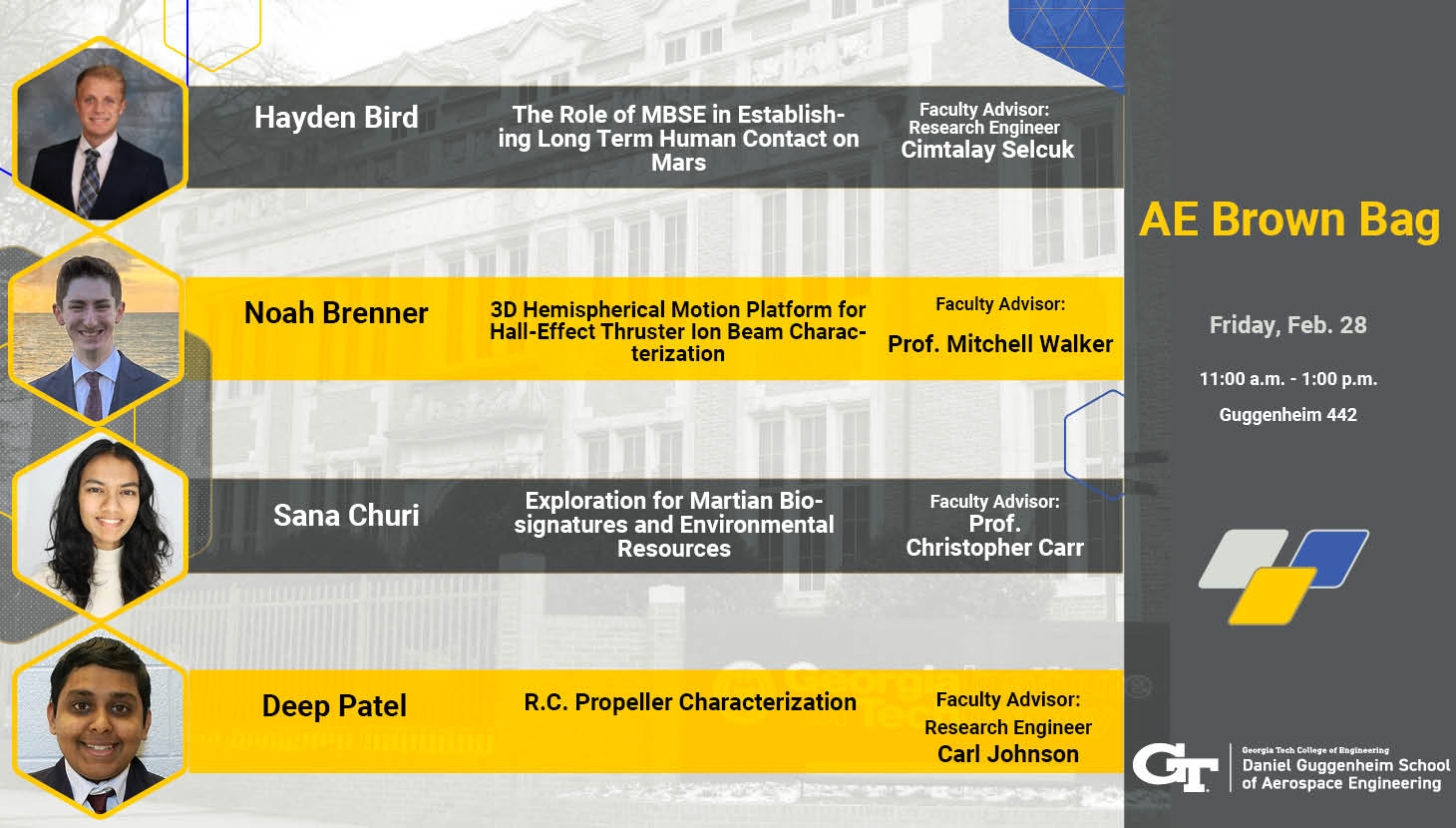
AE Brown Bag Seminar
Friday, February 28
11:00 a.m.
Guggenheim 442
Pizza Served
Hayden Bird
Noah Brenner
Sana Churi
Deep Patel
Hayden Bird
Title:
The Role of MBSE in Establishing Long Term Human Contact on Mars
Abstract:
The exploration and colonization of Mars require reconnaissance systems to identify suitable landing sites and assess surface conditions. This study presents the system modeling of a Mars Reconnaissance Orbiter (MRO) using the MBSE-based CATIA MagicGrid approach, enabling a comprehensive lifecycle analysis and adaptability to real-world mission requirements. Inspired by the Lunar Reconnaissance Orbiter (LRO), this proposed MRO will map the Martian surface, identify potential landing zones, and analyze resource availability using high-resolution imaging, a spectrometer for hydrogen detection, and a coordinate positioning system to identify nine potential long-term colony sites. The mission is structured into three phases: orbital reconnaissance, mapping acquisition for landing site selection, and in-situ surface analysis. NASA JPL’s SPICE dataset informs system requirements, while MATLAB simulations project safe and habitable locations for long-term human presence. This research aims to support future Mars missions by enhancing orbital surveying techniques and optimizing site selection for sustainable exploration.
Faculty Advisor:
Research Engineer Cimtalay Selcuk
Noah Brenner
Title:
3D Hemispherical Motion Platform for Hall-Effect Thruster Ion Beam CharacterizationAbstract:
The primary objective of this project was to design and build a motion platform capable of sweeping a motion platform through a hemispherical region in the plume of a Hall-effect thruster (HET). Once completed, a Faraday probe was mounted to the motion platform and swept through the plume, generating a map of the spatial distribution of ion current. This process was repeated many times for different HET configurations, including variations in azimuthal magnetic field gradients and overall thruster power. Most notably, the results of these tests indicated that increases in azimuthal magnetic field gradients caused by adjusting current through certain electromagnetic coils decreased the thrust and efficiency of the thruster while increasing instability of the thruster’s discharge current oscillation. Additionally, the magnetic field gradients also result in changes in the thrust vector position, further reducing efficiency and introducing moments to the system. These findings underscore the critical role of electromagnetic coils in HETs for maintaining performance, and understanding the effects of azimuthal magnetic field gradients is essential for improving the performance and reliability of HETs in the future.
Faculty Advisor:
Professor Mitchell Walker
Sana Churi
Title:
EMBER: Exploration for Martian Biosignatures and Environmental Resources
Abstract:
As interest in crewed Mars missions grows, the need for further Martian surface characterization and exploration arises. Specifically, it is important to assess the viability of the Martian environment for in-situ resource usage, as well as the presence of biosignatures to indicate the possibility of life and sustaining human life in the future. The Exploration for Martian Biosignatures and Environmental Resources (EMBER) mission proposes a search for organic polymers in regions of Mars with subsurface ice, as well as a stationary in-situ resource utilization (ISRU) unit for oxygen production, propellant production, and plant growth. Subsurface ice regions will be accessed via a RodWell drilling system on a rover, while ISRU production will be carried out on a lander. The lander system is adapted from the Skycrane, which instead lands itself on the surface and carries out data collection. The rover is modeled after Perseverance, with adjustments made to accommodate the RedWater drilling system by Honeybee robotics, as well as other science instruments for sample analysis.
Faculty Advisor:
Professor Christopher Carr
Deep Patel
Title:
R.C. Propeller Characterization
Abstract:
Achieving optimal propulsion system efficiency in remote-controlled (R.C.) aircraft requires a thorough understanding of propeller performance across various flight conditions. This research investigates the impact of aerodynamic modifications, particularly shrouds, on propeller efficiency and thrust. By optimizing shroud geometries, propeller blockage effects can be mitigated, enhancing thrust performance and enabling better selection of motor-propeller configurations for specific applications.
Experiments were conducted using the Tyto Flight Stand 15 in the Low Turbulence Wind Tunnel to characterize propeller efficiency, thrust, and power coefficients. Tests covered airspeeds from 0 to 50 ft/s, with propellers ranging from 10” to 20” in diameter. Data comparisons with APC’s XROTOR models and UIUC’s propeller database revealed that propeller blockage reduced efficiency by up to 20%, while conical shrouds improved accuracy to within 8% of theoretical values.
This research enhances existing propeller performance databases and provides key insights for UAV propulsion optimization. Future work will focus on refining shroud designs, testing additional propellers, and exploring broader subsonic flight regimes to further improve propulsion system efficiency in small aircraft and UAVs.
Faculty Advisor:
Research Engineer Carl C. Johnson